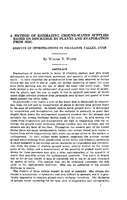A method of estimating ground-water supplies based on discharge by plants and evaporation from soil: Results of investigations in Escalante Valley, Utah
Links
- Document: Report (pdf)
- Plate: Plate 1 (pdf)
- Larger Work: This publication is Chapter A of Contributions to the hydrology of the United States, 1932
- NGMDB Index Page: National Geologic Map Database Index Page (html)
- Download citation as: RIS | Dublin Core
Abstract
Fluctuations of water levels in wells, if critically studied, may give much information as to the occurrence, movement, and quantity of available ground water. In some localities the ground-water level has been observed to decline during the day and to rise at night, the decline beginning at about the same hour every morning and the rise at about the same hour every night. This daily decline is due to the withdrawal of ground water from the zone of saturation by plants, and the rise at night is due to upward movement of water under slight artesian pressure from permeable beds of sand and gravel at some depth beneath the water table.
Study Area
| Publication type | Report |
|---|---|
| Publication Subtype | USGS Numbered Series |
| Title | A method of estimating ground-water supplies based on discharge by plants and evaporation from soil: Results of investigations in Escalante Valley, Utah |
| Series title | Water Supply Paper |
| Series number | 659 |
| Chapter | A |
| DOI | 10.3133/wsp659A |
| Year Published | 1932 |
| Language | English |
| Publisher | U.S. Geological Survey |
| Publisher location | Washington, D.C. |
| Contributing office(s) | Utah Water Science Center |
| Description | Report: 105 p.; 1 Plate: 14.65 x 21.52 inches |
| Larger Work Type | Report |
| Larger Work Subtype | USGS Numbered Series |
| Larger Work Title | Contributions to the hydrology of the United States, 1932 (Water Supply Paper 659) |
| Country | United States |
| State | Utah |
| Other Geospatial | Escalante Valley |


